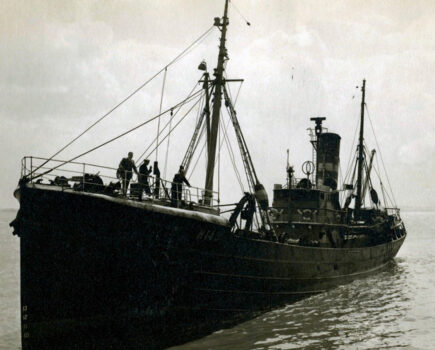Many of the classic wooden boats built by the Dixon’s yard in the 1960s and 1970s are still going strong – and still fishing. Mark Blanchard reports
There aren’t many ports along the south coast between Salcombe and Newhaven, or in the Isle of Wight, that haven’t had a boat built by Dixon and Sons of Exmouth working out of them.
The classic 32ft Dixon encapsulated everything great about wooden boatbuilding in the 1960s and 1970s. From their fine lines to their well proportioned wheelhouses, these inshore boats, built predominantly for potting, were a stepping stone to some of the modern supercrabbers of today.
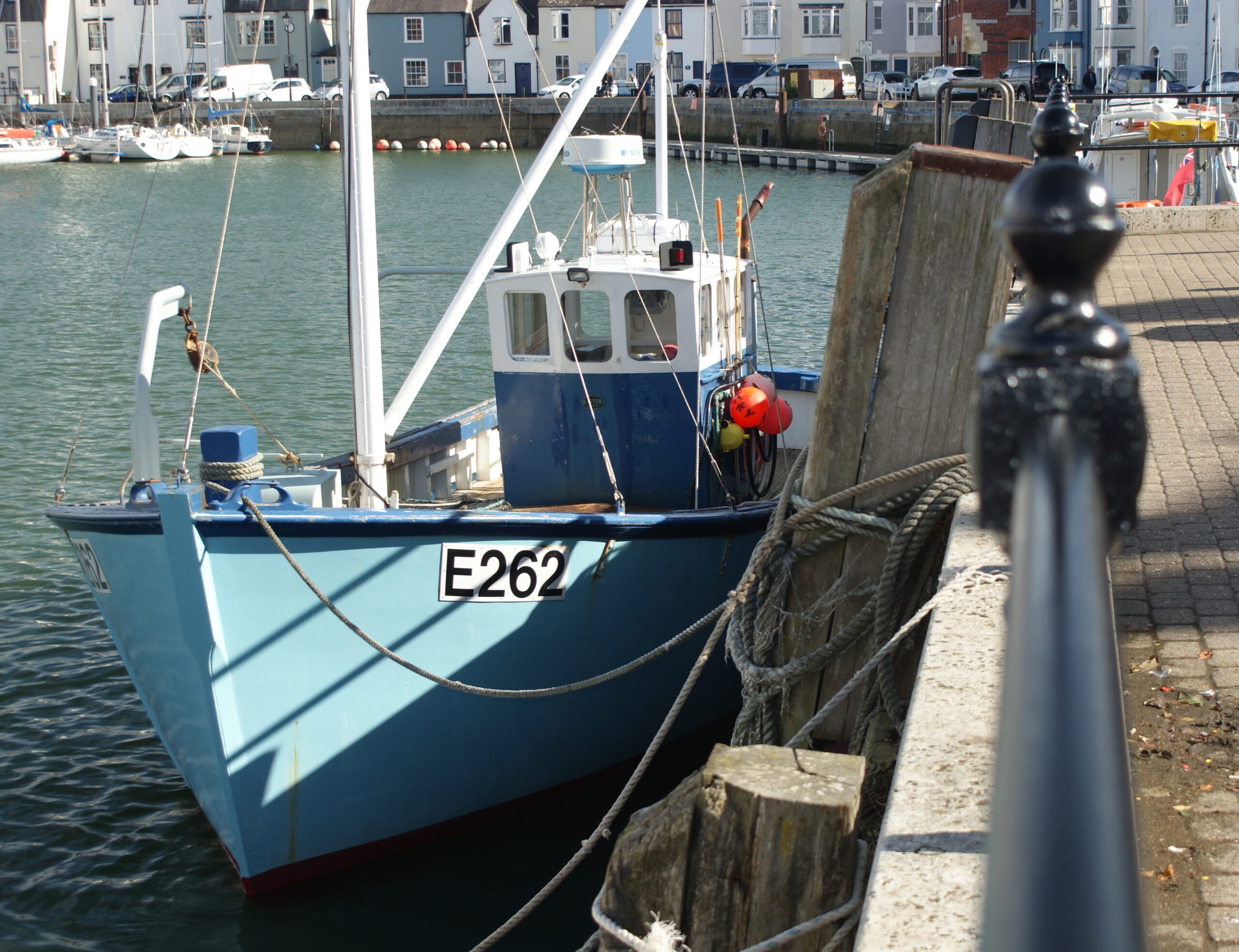
The 35ft Dixon boat Lucky Seven E 262 in Weymouth harbour.
Everything was ‘just right’ with a Dixon boat. They carried a beautiful freeboard and were sheared to the bow. Their fullness forward allowed for plenty of good deck space to stack pots or store baskets of crab, and the trimmed waterline allowed them a good turn of speed.
Although the 32ft was Dixon’s main build, its range of carvel fishing boats went from 24ft to 40ft, and there was absolutely no expense spared in the timber selected to construct these fine vessels.
The earlier boats were built of larch planking, with steamed oak ribs and cut oak frames every 4ft, all copper-fastened. Later builds went on to iroko planking with cut oak frames on 18in centres, fastened with galvanised steel to comply with White Fish Authority build specifications.
Four-inch oak engine beds were fitted that ran half the length of the boat, scribed around the frames. They allowed a 2in gap to the planking so that bilge water never got trapped in the wings. Engines were always the choice of the new owners.
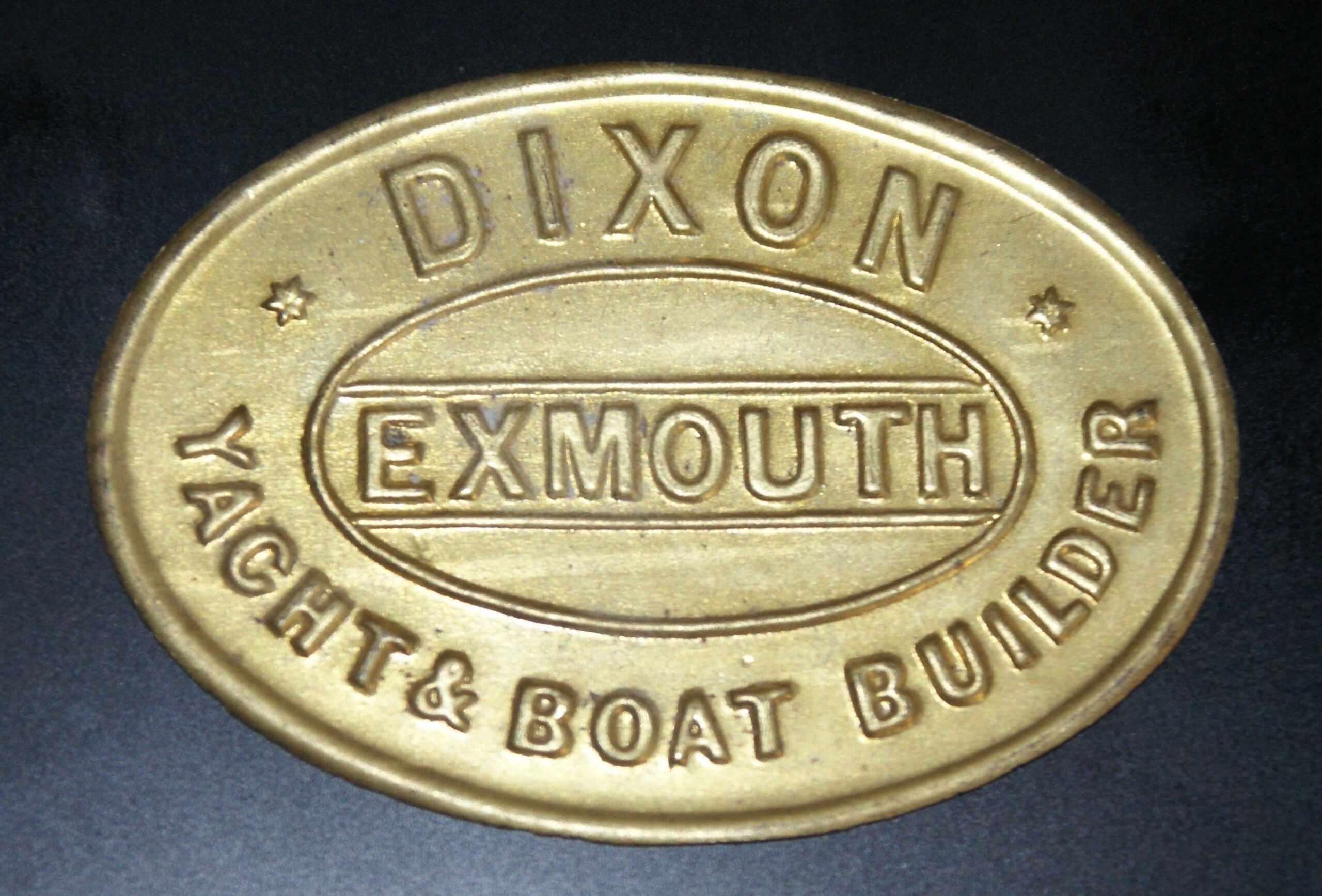
The original Dixon’s brass builder’s plaque.
The aft wheelhouses all followed a similar pattern: three windows forward, with a sliding door on the starboard side, allowing the skipper to help the crewman shoot pots when they were only working two-handed. A ‘box’ was built out from the after side of the wheelhouse to accommodate a bulky ‘Sailor Big Set’ VHF radio, and several of the boats had a gas ring in a biscuit tin on the wheelhouse floor, allowing them to boil a kettle – a precarious job back in the day, as I nearly found out to my cost when I was crewing, almost setting an oilskin smock on fire.
The Dixon boats were nearly all built as potters, with mechanical capstans fitted forward, with a small roller on the gunwale to guide the rope. The skipper generally worked the capstan with the crewman ‘on the rail’ lifting the pots in – a backbreaking job before davit arms came into use.
The pots were usually stacked from forward to aft in rows down the port side, meaning that when shooting away, the crewman could leave a pot half on the gunwale for the skipper to pay over the side when the rope came tight, whilst half in the wheelhouse steering.
Some of the boats had ‘back to back’ steering on the outside of the wheelhouse, allowing you to control the boat from the deck, and most had a second mechanical gear lever forward next to the capstan, to allow you to keep the boat ‘up on the gear’ when hauling in tide.
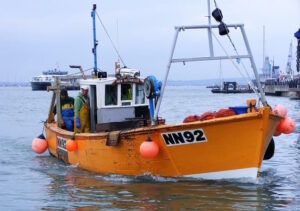
The 32ft New Aquarius, built for the Gilliam family in 1971.
Some also had trawl winches fitted to allow them a different method of fishing in the winter, as inshore potting in the 1960s and 1970s was predominantly seen as a seasonal fishery. A lot of the Dixon boats also got involved in lucrative oyster dredging at times. Oyster fishing in some of the estuaries and backwaters on the south coast, around Poole harbour and in the Solent, was a financial lifesaver in the winter when the weather was bad.
A scaffold plank ‘table’ was fitted from gunwale to gunwale across the transom, and the oyster dredges were worked from there. If the boats did not have trawl winches, a block was fitted on the aft gantry, with the warp running through it, allowing the dredge to be hauled by the capstan.
Over a period of 29 years, between 1950 and 1979, Dixon and Sons built over 35 commercial fishing boats, along with numerous clinker-built punts, sailing dinghies, harbour launches and gentlemen’s yachts.
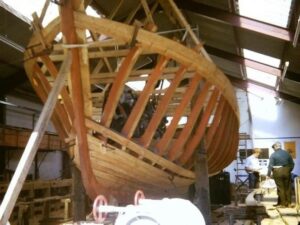
The New Aquarius, ready for planking.
The family company was started by Sam Dixon at the turn of the 20th century in a small yard near Exmouth seafront. Soon after, it also took over a slightly bigger second yard in St Andrew’s Road. Downstairs, the boats were framed out and planked, and upstairs was a drawing loft and template store. The office was housed in ‘The Cottage’ at the back of the workshop, with the primary aim of keeping sawdust off the typewriter ribbon.
St Andrew’s Road was a walk from the foreshore, so each time a boat was finished and ready to be launched, a mammoth operation was undertaken. A set of timber tramlines, 25ft long, were set up, and all the staff were tasked with pasting them with tallow. The boat was then towed by tractor along the greased ‘skids’ to the slipway and launched. This was an early-morning operation, as arrangements with the police and council meant the road had to be clear for passing traffic again by 8am.
The company employed at least 17 men in its heyday and provided a good source of local, well-paid, skilled jobs. A lot of Dixon’s staff went on to start out on their own, taking fine traditional wooden boatbuilding knowledge with them.
Before each boat was built, a 1in:1ft scale model was constructed to ascertain the exact dimensions for cutting each component. Every piece of wood that went into a Dixon boat was scribe-cut and then painted on the back before being fastened to give longlasting protection.
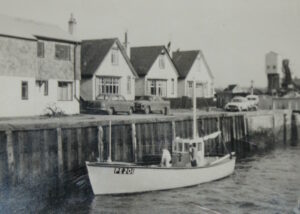
The 30ft Avon Maid, built in 1960 and now working out of Mudeford.
Sam Serle, an Exmouth-born man, started his boatbuilding apprenticeship with Dixon’s in 1958 and worked for the company right up to its closure, ending up as foreman. Narrowly missing National Service meant that Sam could continue his career without a break, unlike apprentices before him.
Sam was employed by the second generation of the Dixons – three brothers: George, Reg and Henry, who was more commonly known as ‘Turps’ as part of his weekly duty was to collect the yard’s turpentine spirit from the pier.
Sam now works as a volunteer in Exmouth museum, and is very proud to show off the cabinet relating to Dixon’s nationally recognised boatbuilding presence in the town.
In the early 1970s, Dixon’s moved to larger premises at 1 Dock Road, Exmouth. The company needed more room as its builds got bigger.
Before they moved to this single base in Dock Road, the rivalry between the two Dixon workshops had been intense – almost like two separate businesses, always trying to outdo each other – but to George, Reg and Turps this only meant one thing: the build quality was going up and up.

Sam Serle, Peter Dixon and Andy Gallop.
When the third generation of Dixons, John and Peter, retired, the premises at 1 Dock Road were taken over by the Exmouth Dock Company.
Many of the boats built by Dixons, some the best part of 50 years old, are still going strong and working commercially. All have switched over to hydraulic slave haulers from capstans, many have new engines, and most have had new wheelhouses or wheelhouse extensions built to house the array of electronics that inshore boats now carry.
The area to the western end of the Solent, around Lymington and Mudeford, was a magnet for Dixon boats in the 1960s and 1970s. These boats replaced the more traditional 20-footers of the area, allowing fishing further offshore.
In 1963, Twynham Trawlers of Christchurch, owned by partners Ian Ashby and Ted Bishop, had the 32ft Just Friends built at Dixon’s. She was powered by a Gardner 3LW. They fished her for lobster on the lucrative grounds between the Needles and St Catherine’s Point off the Isle of Wight – they say that when they were first out there, they never saw another pot! After the autumn potting finished, they worked her out of Poole in the winter, pair-trawling for sprats – a mainstay inshore fishery during January at the time.
A couple of years later, Ian Ashby and Ted Bishop had a second 32-footer built at Dixon’s, the Blossom Jill PE 48. She was powered by a larger Gardner 4LW and fished the same area. The Blossom Jill was later sold to Poole fisherman Robert Channon, who renamed her Nicholas C. She is still fishing out of Selsey in West Sussex under new owners.
Ted Bishop went on to have the 32ft Page 3 built by Dixon’s – she was powered by a yet larger five-cylinder Gardner. The Page 3 was sold up to Milford Haven for whelk fishing, and is now in Northumberland, renamed Northern Soul.
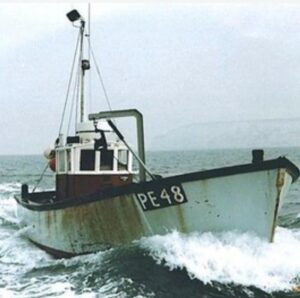
The 32ft Blossom Jill.
Another couple of Dixon boats in the area were the 30ft Avon Maid, built in 1960 and working out of Mudeford, and the 36ft Shearwater SU 206, working out of Lymington.
Further west, the Lynn family from Beesands in Devon got the 40ft Skerry Belle DH 63 from Dixon’s in 1974. They worked her out of Dartmouth, fishing grounds off Start Point. The area was synonymous with the hen crab fishery, and the larger 40ft boat had excellent carrying capacity. The pots were a lot larger than the gear used further up the coast to the east for lobster, and it wasn’t unusual to see them coming up half-full of crab after a three-day lay.
Graham Lynn owned and ran the Skerry Belle for over 40 years and has only recently sold her. He was one of the first skippers to have a davit arm and block, rather than a small gunwale roller, to save having to ‘lift in’. Graham told me that in all the years he had the Skerry Belle, she never made a drop of water. She is still going strong, now fishing out of Newlyn.
Moving round to West Wales, Winston Evans, coxswain of the New Quay lifeboat, had the 36ft Catherine Arden built in 1971. She was powered by a Lister engine, potting for lobster in the summer and trawling in the winter. However, Winston had to retire from fishing due to ill health, and now skippers a tripping boat.
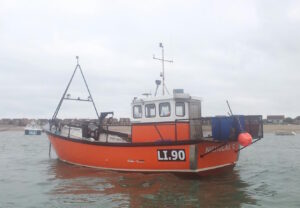
Nicholas C – formerly the Blossom Jill.
The 32ft Heart of Oak E 14 was the first boat to be built at 1 Dock Road, for West Bay skipper Rex Woolmington. Built as a trawler, she was powered by a Lister engine and had a Brixham trawl winch fitted.
Little Sister PE 52, built in 1968, was another fantastic 32ft Dixon to join the Dorset fleet. Martin Meluish fished her out of Swanage in the early 1970s, and then sold her to Mervin Williams in Poole. Merv was a keen trawlerman, so had a trawl winch fitted for a few years before swapping back to lobstering. Sadly, his long serving deckhand Robert ‘Blondie’ Beavers was lost one night while out ring-netting for bass in his Poole canoe.
The Gilliam family from East Sussex was also closely associated with Dixon boats. Ted Gilliam had the very last boat out of the yard in 1981 before its closure – the 39ft Toby Roc NN 404, arguably one of Dixon’s finest builds. Exactly 10 years earlier, in 1971, he had the 32ft New Aquarius built at the yard.

Toby Roc ready to have her deck laid.
Another fine example is the Bolt Head Queen SE 27, built 40ft long for Salcombe skipper Ken Richards in 1970. He used to fish her out of Salcombe on the hen crab in the autumn. In the spring, he used to steam her to Wales and work out of Milford Haven on the lobsters, taking all his gear there on a lorry. The Bolt Head Queen is still doing well after 50 years and has only had one new owner – Edwin Stokes of Chichester. She still has her original 72hp Gardner 5LW engine, although the vessel did have a major rebuild in 2010, at a cost of £11,000.
Lucky Seven E 262 is another great Dixon boat, owned by brothers Norman and Allie Miller in Dorset. At 35ft long with a Lister HRW6, she sticks solely to potting. In the summer they run her out of Lulworth Cove, where the Miller family have fished for generations, moving to Weymouth harbour in winter when the weather is bad.
Amongst other Dixon potters working along the Dorset coast in the very early 1960s were the 32ft Lucky Me PE 21, owned by lobster legend Maurice Lane, and the 32ft Harry Whiterow WH 388, owned by the Mansell family. The Mansells also had two smaller Dixon boats that fished out of Kimmeridge Bay on the ledges.
These fine vessels, and many more built by Dixon and Sons of Exmouth, will hold a place in the British fishing industry for many years to come.
This story was taken from the archives of Fishing News. For more up-to-date and in-depth reports on the UK and Irish commercial fishing sector, subscribe to Fishing News here or buy the latest single issue for just £3.30 here.






